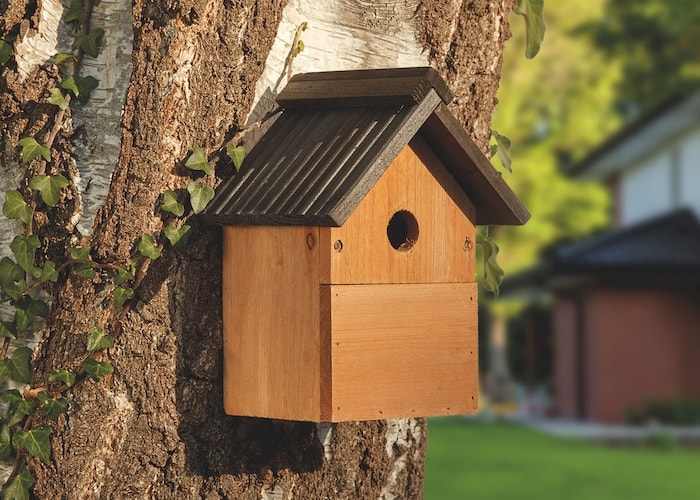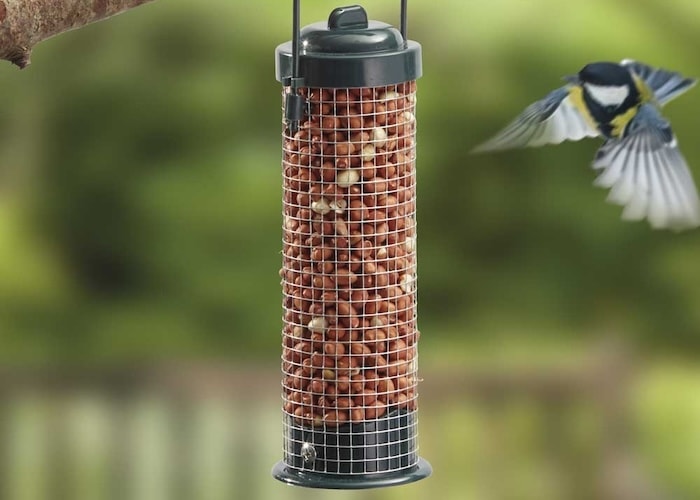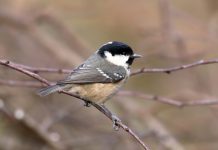A combination of bird food, fresh water and shelter are a good way to encourage local birds to visit your garden. But if you’re looking for tried-and-tested advice from wildlife bloggers and bird-loving Instagrammers, we’ve got you covered. Whether you’re taking part in this year’s Big Garden Birdwatch or just enjoy filling your garden with feathered friends, these expert tips will help…
Where’s the best place to put a bird feeder?

Image: Nature’s Market Premium Bird Table with Built-in Feeder from Happy Beaks
Providing plenty of bird food is one of the quickest and easiest ways to get birds to visit your garden, but finding the perfect spot for your feeders can be tricky. The ideal location involves a delicate balance between accessibility, safety and convenience. Get it wrong, and avian visitors may not come.
Winners of the Sustainable Living Blog of the Year 2021 and 2022, Mars and Kirsten from My Home Farm have a wildlife-friendly garden in mid-Wales. Their advice is to: “position your feeders in a spot that’s visible to birds from a distance, such as against a clear sky or a contrasting background.” Make sure you can see them too, perhaps near a window from which you can enjoy watching the birds’ antics but far enough away that they won’t fly into the glass.
Devon-based wildlife photographer Nick de Cent (@nick_de_cent_wildlife) reminds us to think about predators when positioning bird feeders. A master of capturing incredible photos of animals in their natural habitats, he says, “the feeder should be far enough away from any bushes where cats could conceal themselves, and also offer birds a clear view of what’s around them so they have the best possible chance of spotting avian predators (such as sparrowhawks).”
Natalie from Vale Wildlife Hospital & Rehabilitation Centre says that bird feeders are best placed in a quiet location close to the natural ‘shelter’ of trees and shrubs. Treating over 7,500 wildlife casualties every year, about 70% of which are birds, this wildlife hospital worker knows her stuff. Before making their move, birds like to scope feeders from a leafy hideout and return quickly to safety once they’ve fed.
How do you attract lots of different types of birds to your garden?

Image: Kingfisher Deluxe Bird Feeding Station with Feeders from Happy Beaks
If you get plenty of birds in your garden but lack variety, our experts have lots of ideas to help you entice other species. Natalie, the avid bird watcher behind @gardenbirdgeek says she puts out different types of food to appeal to different sized birds. She says; “I use a premium mixed seed, suet-based fat balls, sunflower hearts, mealworms, seedless grapes and then kitchen scraps such as bread, cheese, Yorkshire pudding, cooked bacon rind etc.” Just check that any scraps are definitely safe for them to eat first.
Kabir Kaul, an award-winning blogger and young conservationist who works with several charities (including the RSPB) researches the types of food that different birds prefer: “for instance, goldfinches feed on sunflower hearts, robins prefer mealworms and seeds, and blue tits often eat peanuts.” Make sure you buy the most suitable feeder for each type of bird food, he adds.
In the same way that each species has a favourite type of food, presenting the food in different ways is also important. Nick from @nick_de_cent_wildlife suggests a combination of hanging feeders, bird tables and ground feeding stations. He also recommends planting shrubs and trees that produce berries or seeds, and including lots of plants to attract insects, another important food source for many birds.
If improving the variety of food and providing multiple feeding areas doesn’t do the trick, Natalie from Vale Wildlife Hospital & Rehabilitation Centre suggests creating a quiet corner free of children and pets. “If you have a busy, noisy garden, it’s unlikely birds will come to feed,” she explains.
How do you attract small birds to your garden?

Image: The Nuttery Squirrel-Proof Helix Seed Feeder Celadon Green from Happy Beaks
To specifically attract small birds, Mars and Kirsten from My Home Farm use feeders with smaller perches and narrow feeding ports filled with millet and niger seeds. They also recommend caged feeders that only allow small birds to enter, providing them a safe feeding environment away from larger birds and predators.
Emma Reed, a trainee veterinary nurse turned eco-friendly blogger, agrees that hanging feeders are much more tricky for large birds to feed from. She says that suspending them from tree branches allows small or nervous birds to flit in and out quickly, but you might need a squirrel-proof model to stop these acrobatic mammals from stealing all the treats!
Alex Foster, the education and outreach co-ordinator at Brent Lodge Wildlife Hospital, says that whatever type of feeders you use, try to avoid “cheap seed mixtures that may contain split peas, large dog biscuits, beans, dried rice or lentils as these attract larger predatory species”.
And remember that smaller birds are drawn to gardens with hedges and plenty of shelter, says Natalie from @gardenbirdgeek. Filling your space with trees, bushes and shrubs will make them feel at home. “Small birds also enjoy a birdbath,” she adds!
How do you attract birds to nest in your garden?

Image: Gardman Multi Nest Box from Happy Beaks
Enticing birds to visit your garden is one thing, but encouraging them to build nests and stay more permanently is quite another. Watching chicks grow and fledge is a real treat, so anything you can do to attract mating pairs is always worth the effort.
According to Emma Reed, “birds choose to nest in gardens that provide them with food, water, shelter and a safe environment for their young to fledge in.” In addition to bird feeders, she recommends adding a small pond or dish with water, and planting some trees or large shrubs to encourage long-term residents.
Nick from @nick_de_cent_wildlife agrees that you should provide as much variety in nesting opportunities as possible. “So, shrubs and trees are obviously good, as are climbing plants such as ivy.” If you’re hoping to attract specific birds, research the type of nest box they prefer (open-fronted or with an access hole) and position them correctly. “[There are] specialist nest boxes for species such as house martins, owls, sparrows, and so on,” says Nick.
When it comes to choosing the best position for nest boxes, Natalie from Vale Wildlife Hospital & Rehabilitation Centre recommends placing them out of direct sunlight (facing north and east) and somewhere that’s protected from wind and rain. And don’t forget to think about accessibility, she says. “It’s important to ensure there is a clear flight path for birds to enter and exit.”
In order for birds to feel safe, Natalie from @gardenbirdgeek says that nest boxes should be raised at least 3m high from the ground. But no matter how appealing you make them, some birds will always prefer to build their own nests rather than take up residence in a man-made one. “To encourage natural nesting, plant trees such as conifers and evergreen bushes,” she recommends. This is a good way to make your garden attractive to small, more timid birds, as they appreciate somewhere to hide all year round.
And if you’re fortunate enough to have hosted a bird family, Alex Foster from Brent Lodge Wildlife Hospital reminds us of the need to thoroughly clean bird boxes between September and Jan before they’re needed again. She says that “birds won’t use them if they have old nests in them and it also reduces any risk of disease/infection for the new family.”
How do you keep pigeons away from bird feeders?

Image: Nature’s Market Wild Bird Nut Feeder from Happy Beaks
If you’re trying to reduce the number of pigeons that descend on your garden at feeding time, Catherine from the award-winning blog Growing Family suggests using feeders with a seed tray to “limit the amount of seed that falls to the ground, which is where pigeons like to feed.” But, she adds, “if you’re happy to have pigeon visitors but just want to give smaller birds more opportunities to feed, you could create a separate feeding station at ground level to tempt pigeons away.”
Another way to keep large birds like pigeons off your feeders is to choose models without perches, suggests Nick from @nick_de_cent_wildlife. That way, only the most acrobatic birds (such as blue tits) can use them and the pigeons will be forced to feed on the ground.
According to Natalie from Vale Wildlife Hospital & Rehabilitation Centre, pigeons aren’t very interested in food like suet balls, making these a good choice in urban gardens. But rather than seeing pigeons as a pest, Natalie suggests embracing them as part of nature and encouraging them to clean up spillage from your bird feeders.
That’s the approach that Natalie from @gardenbirdgeek takes. She doesn’t try to keep pigeons out of her garden. In fact, she says “I love them as much as any other bird.” Natalie says that, because they struggle to land on the feeders, they stay away from the smaller birds and usually just eat from the bird table.
What not to feed wild birds?

Image: Premium Goldfinch Mix from Happy Beaks
There’s lots of conflicting information about what is and isn’t safe to feed to wild birds. Alex Foster from Brent Lodge Wildlife Hospital shares a helpful list:
- Any whole nuts that could pose a choking hazard (e.g. whole peanuts) should be avoided – especially in the spring/summer when babies are feeding.
- NEVER use salted or dried peanuts as these can be toxic.
- Never give wildlife, including birds, dried bread or milk, as their bodies are not designed to digest them and it can cause serious problems or even prove fatal (to birds and hedgehogs).
- Similarly, fruit seeds and pits are equally dangerous/toxic.
- Especially avoid any foods that are spoiled, mouldy or just generally “off”.
- Avoid using vegetable oils, cooking fat or margarines when making your own fat balls, as they contain high salt levels and can smear on the birds’ feathers. Homemade fat balls can also go soft/rancid in the summer and become a bacteria breeding-ground, so it’s best to buy good quality fat balls instead.
- Dried, loose oats are fine but never cook and leave out porridge oats, as these can solidify around birds’ beaks.
- Never put out any food that is in mesh bags. Remove the bag as these can trap or injure birds.
- Only buy certified bird feeders.
Natalie from Vale Wildlife Hospital & Rehabilitation Centre agrees. Her best advice is to concentrate on bird-specific foods. “Whilst you are able to safely provide some food from your household (fruits without seeds or pits, for example) some foods can actually be toxic. Where we once used to feed bread regularly, we now know that, although it’s unlikely to cause serious problems if eaten in small quantities, bread has very little nutritional value. It’s always best to feed birds with high-quality food, to ensure they’re receiving the right nutrition.”
We hope these tips help to bring lots more birds to your garden this year. Check out our Big Garden Birdwatch – Quick Identification Guide if you’re not sure how to record each species, and have a go at our Bird Bingo game for a fun way to get kids involved.
Expert contributor list:
- Mars and Kirsten, My Home Farm, winners of Sustainable Living Blog of the Year 2021 and 2022.
- Nick de Cent, @nick_de_cent_wildlife, Devon-based travel and wildlife photographer.
- Emma Reed, From trainee veterinary nurse to a freelance writer and eco-friendly blogger.
- Natalie, Vale Wildlife Hospital & Rehabilitation Centre, treats over 7,500 wildlife casualties every year.
- Kabir Kaul, award-winning blogger, young conservationist, Mayor’s London Rewilding Taskforce between 2022 and 2023.
- Natalie, @gardenbirdgeek, keen bird watcher with Instagram page dedicated to aves.
- Catherine, Growing Family, award-winning home, garden and nature blogger.
- Alex Foster, Education and outreach coordinator at Brent Lodge Wildlife Hospital.
























